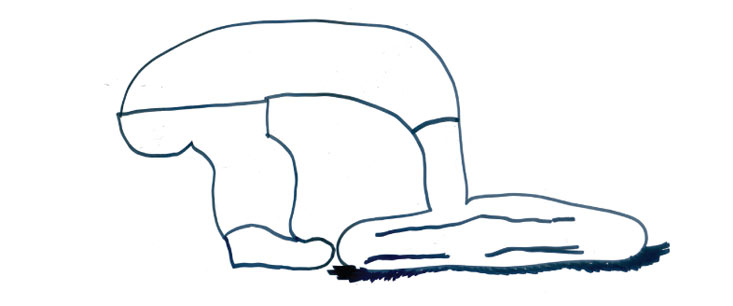 Daniel Johnston
Daniel Johnston
and his Music
Tomasz Misiak
His records gained recognition among icons of contemporary rock music. Daniel Johnston’s pieces were performed by such artists as Tom Waits, Sonic Youth, Pearl Jam, Beck, The Flaming Lips. This is just a fraction of a long list that bears testimony to the fascination that Johnston’s work stirred among musicians regardless of aesthetic and ideological divisions. His music was praised for sincere lyrics as well as rough sound and formal simplicity. Praises of Johnston sung by David Bowie are well-known and frequently evoked, and so is the story with Kurt Cobain, who once performed dressed in a t-shirt with the cover of Johnston’s album (Hi, How Are You: The Unfinished Album from 1983), thus undoubtedly contributing to a rise in popularity of his unconventional art. That popularity became a blessing and a curse at the same time. A blessing – since it allowed him to find fulfilment in frantic creative work knowing that the results will see the light of day. A curse – since the visibility that it brought proved to be too heavy a burden for the introvert with a bipolar disorder.
What is Daniel Johnston’s music like? Seeking to trace categories that could afford at least an approximate definition, music encyclopedias hint at a web of affiliations stretching between rock, folk rock, indie rock and lo-fi aesthetics. His music is more and more often described with the prefix americana, since it has been recognised to embrace a complex conglomerate of the most important influential traditions in the US, primarily blues, country and rock & roll. Yet, the artist processes them in his own unique way, turning his music into an example of such tendencies as alt-country, cowpunk and y’allternative. As much as none of this is false, Johnston’s work – a statement far from truism in his case – escapes established schemes and aesthetic categories.
So what music does Daniel Johnston make? Although helpful, the above enumerated genres provide a merely blurred vision woven of vague references. Over and above these categories, can we distinguish any universal traits of Johnston’s music, which offer themselves to view throughout his rich and varied oeuvre? I think such characteristics do exist, and include: repetition, experimentation with audio cassette tape, and lo-fi aesthetics, which – in his case – does not result from a pre-meditated vision of desired sound, but from the use of limited technical means in the recording process.
The vast majority of Johnston’s pieces are songs with acoustic guitar accompaniment. They are characterised by such intriguing features as multiple repetitions. In some of them, Johnston repeats simple guitar riffs with an admirable consistency, or else in the grip of an obsession, in a desire to push to the extreme a simple initial motif on which an entire composition is based. For an experience listen to Sorry Entertainer from the album Yip Jump Music (1983). The song’s trancey air and relentless repetition hold a seductive appeal. Echoes of The Velvet Underground? Of course! No wonder Johnston later found common language with the band’s drummer Maureen Tucker, a collaboration that bore the fruit of the song Do It Right from Tucker’s second album Life in Exile after Abdication from 1989.
Johnston released almost all of his compositions on cassettes. He recorded his early pieces with whatever was at hand, for instance toy organs and a tape recorder found in his brother’s garage. The audio cassette, with its characteristic hum, became the basic tool in building his lo-fi sound, which – as sound producers would say – manifests an unfavourable proportion of signal and hum. Johnston’s records are therefore full of noise, grimy, and as if otherworldly, as we could call them from our modern-day perspective that prioritises the quality of the recording, while hum and rattle is deliberately generated with meticulous procedures. Yet, tape recorder had yet another use: it made it possible to regulate the pace of tape, and thereby experiment with time. Alternate acceleration and deceleration of the recording is a ritual of putting a spin on reality that Johnston sometimes performs to manifest opposition to its ossified form – as can be heard in the short song Go, followed by Fast Go from the album Respect (1985).
Johnston’s rough recordings did not pass the test of
a professional recording studio. The artist’s flirt with the mainstream, which bore the fruit of the album Fun (1994), was an example of a misalliance with no future. Album sales did not meet the commercial expectations of the Atlantic record label, and so the unequal cooperation came to an end. After all, Johnston is an outsider who could never become a cog in a music hit production machine. He is a master of hits à rebours. So Irwin Chusid may be right to hail Johnston as one of the most outstanding outsider musicians in his famous book Songs in the Key of Z: The Curious Universe of Outsider Music. “Outsider musicians can be the product of damaged DNA, alien abduction, drug fry, demonic possession or simply sheer obliviousness. About the only things these self-taught artists have in common are an utter lack of conventional tunefulness and an overabundance of earnestness and passion”1 – writes Chusid. If so, Johnston surely retains a special place in that group.
